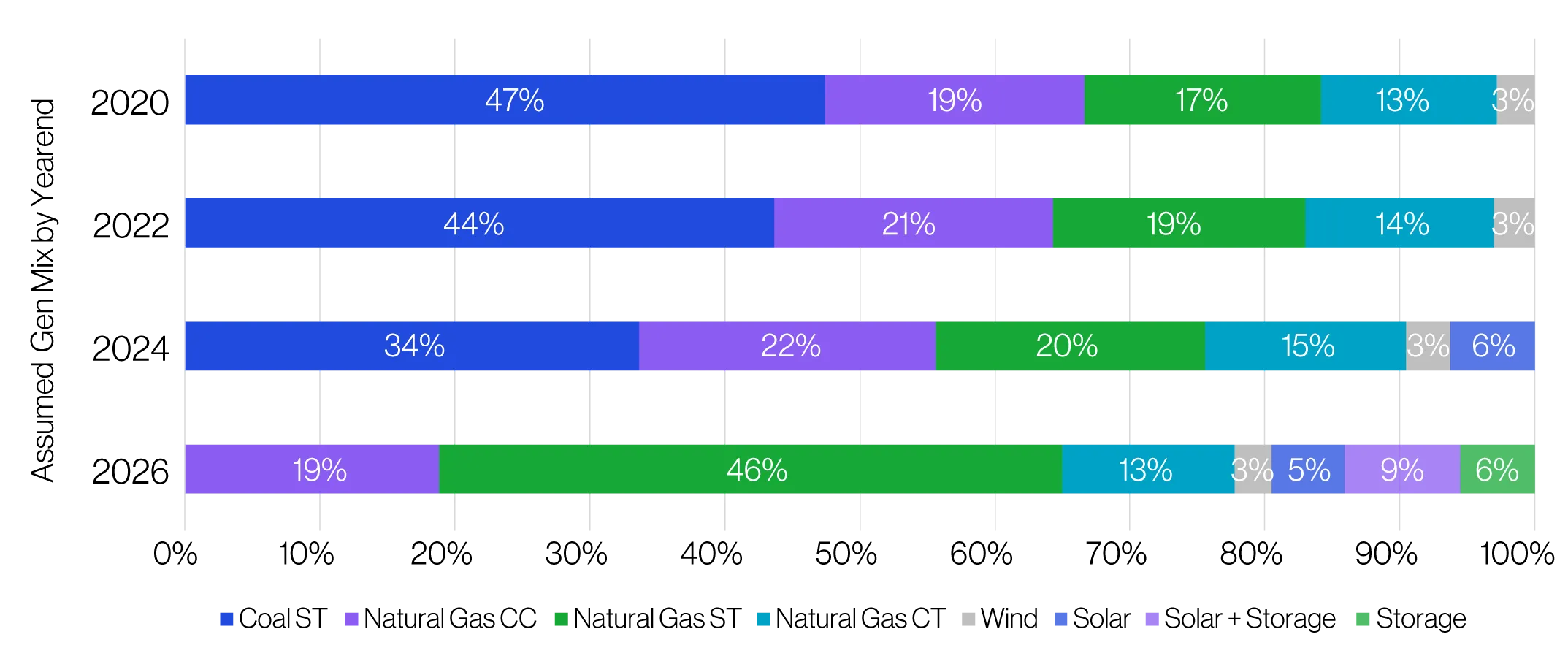AES Indiana has powered an energy transition with a balanced and diverse energy mix to serve our customers’ needs for more than a decade with grid capacity, stability, and resiliency in mind. Our generation investments are focused on cleaner, more efficient options, including natural gas, wind, solar, and battery storage.

AES Indiana resource mix
AES Indiana’s Integrated Resource Plan (IRP) continues to guide AES Indiana’s energy transition. AES Indiana currently has 3.9 GW of generation resources comprised of natural gas, wind, solar, and two coal units that are anticipated to be repowered to natural gas by the end of 2026. The figure above shows how AES Indiana’s resource mix has changed over time.
Repowering conventional generation In November 2024, AES Indiana received approval to repower the last two remaining coal units at Petersburg Generating Station. Through the 2022 IRP, AES Indiana discovered the cost of operating some coal-generating plants exceeds the value customers receive compared to alternative resources. This additional cost comes from the operation and maintenance of processes associated with coal-fired generation like coal handling and emission controls. As renewables decline in cost, technology adapts and customer preferences shift, AES Indiana continues to identify least-cost options for energy storage and generation and move toward cleaner energy resources.
Solar and Wind
Hardy Hills solar project, Clinton County, Indiana
- 195 MW solar generation
- Acquired in 2021, online in May, 2024
- Can power more than 35,000 homes
Hoosier Wind Park, Benton County, Indiana
- 106 MW wind generation
- Acquired in 2024
- Can power more than 29,000 homes
Petersburg Energy Center, Pike County, Indiana
- 250 MW solar generation
- Announced in 2024 and scheduled for completion in 2026
- Will be able to power about 100,000 homes
CPCN for Crossvine Solar/Storage, Dubois County, Indiana
- 85 MW solar generation
- Filed with IURC in 2024 and anticipated order in 2025
- Will be able to power more than 14,500 homes
Target ~364,000 MWh per year of DSM and energy efficient programs
AES Indiana continues to be a state leader in Demand-Side Management (DSM) implementation and through an extensive valuation of DSM bundles, compared to supply-side alternatives, will target 364,000 MWh of DSM in the 2025-2026 plan. Here is a list of current programs available to help AES Indiana customers manage their energy usage.
Energy resources and storage
Combined cycle gas turbine (CCGT)
CCGT combines a natural gas-fired turbine and a steam turbine to produce electricity more efficiently and with fewer environmental emissions than other thermal energy options available in Indiana today.
Energy storage
The Pike County Battery Energy Storage System (BESS) will be one of the largest battery energy storage systems in the MISO footprint. It is anticipated to go online in 2025 and is a significant step toward greener, smarter energy solutions for AES Indiana customers.
Pike County Battery Energy Storage System (BESS)
- Can store and deliver 50MW per hour, for 4 hours
- Anticipated COD: 2025
- Can power more than 38,000 homes
Petersburg Energy Center, Pike County, Indiana
- Can store and deliver 60 MW per hour, for 3 hours
- Announced in 2024, scheduled for completion in 2026
- Will be able to power about 100,000 homes
CPCN for Crossvine Solar/Storage, Dubois County, Indiana
- Filed with IURC in 2024 and order anticipated in Spring 2025
- Can store and deliver 85MW per hour, for 4 hours
- Will be able to power more than 14,500 homes
Utility mercury and air toxic standards (MATS)
AES Indiana has invested in new and upgraded environmental controls at its Petersburg generating station and converted all of the units at its Harding Street Station to natural gas to comply with new Utility Mercury and Air Toxic Standards (MATS) set by the Environmental Protection Agency (EPA). Read more.
Harding Street Station
AES Indiana stopped burning coal at the Harding Street facility in February 2016 and refueled the units to natural gas. These conversions are part of AES Indiana's overall MATS and waste-water compliance plan for its power plants and will eliminate the need for a coal pile and ash ponds. Read more.